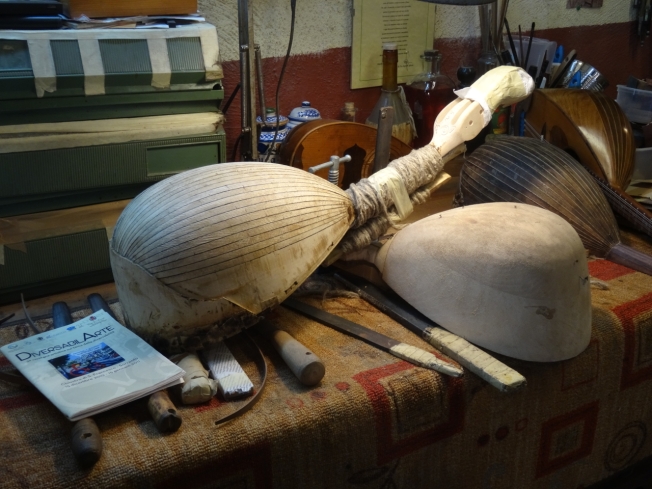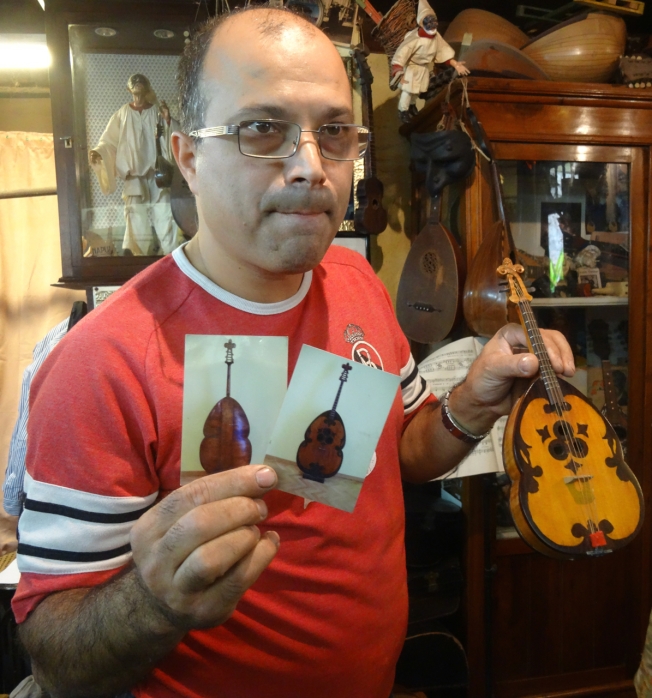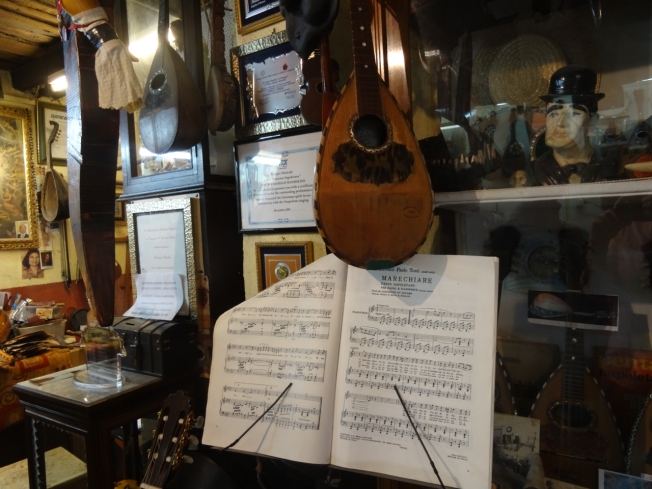It took us a while to find the little workshop and we had to squeeze in when we did – it was Saturday and the only door was open to visitors.
In fact La Bottega del Mandolino was so full of visitors (around a dozen or so), and every shape of mandolin and tool, that there hardly seemed space for Maestro Salvatore Masiello.
But there was … and after a few minutes of jostle for camera angles, space was found for Salvatore Masiello to talk us through the history of the mandolin in Naples. The lively to and fro was in Italian but by the end of it we knew for sure that we loved the mandolin and that there were three names in the instrument’s Neapolitan history that really mattered … Vinaccia, Calace and Japan.
It was beyond our language skills that Saturday to understand why they mattered but since our visit I’ve done some research and here’s what I’ve discovered.
- Music, and musical instruments from around the world have always washed into the port of Naples and gone on to influence what the city itself creates.
- By 1740 the city’s creations were spreading outwards thanks to its prestige as the cultural capital of Europe.
- This cultural dominance was thanks to the arrival six years earlier of Carlos, a teenager from the Spanish House of Bourbon, who turned his new realm, Naples, into an independent kingdom with huge palaces, a luxurious opera house and a reputation for fine musicians and music teachers.
- It was a good time to be in the ‘industry’. Amongst those who did well were members of the Vinaccia family of luthiers who were hard at work on what would develop into the mandolin. Their creation, different from the stringed instruments that had come before, soon found its way into orchestras across Europe.
- Their Neapolitan mandolin included: a deeper body than usual (the bowlback); the same tuning as the violin; the use of plectrum; and a canted soundboard (front) so the strings could be even tighter than usual.

Booklet ‘DiversabilArte’ detailing the instruments for the disabled designed by the ‘Bottega del Mandolino’
It was a great success for a while … and then it wasn’t. There were two reasons for this.
The first was ease of use. Steel strings were not invented yet and orchestras grew frustrated with tuning the brass and gut strings of this new mandolin.
The second was the clash for cultural greatness. By the late 18th century the city of Naples had to bow towards Vienna where – partly thanks to Mozart, who died in Vienna in 1791, and Beethoven, who died in the city in 1827 – a new passion for violin and piano had been born.
Suddenly the mandolin, once embedded in the classical orchestras of Europe, found itself pushed out to the edges – to folk music and to tourists.

Luthier Salvatore Masiello with tiny replicas of the stringed instruments that have meant so much to Naples and the mandolin
It might all have ended there if it hadn’t been for the arrival of steel strings in the late nineteenth century and the discovery of a new champion in Naples – the Calace family of luthiers.
The Calace business soared when the founder’s grandsons – Nicola and Raffaele – came of age. The most gifted player of the pair was Raffaele Calace whose talents as a performer, composer and luthier, took the mandolin back to centre stage.
His talents are still sighed over today thanks in part to publicity and timing.
Raffale Calace was born two years after the unification of Italy in 1861, and the ‘luck’ for him and the mandolin was that the princess destined to become the first Queen of Italy was the beautiful, musical Margherita of Savoy who played and promoted the mandolin. Her high profile and Raffaele’s exquisite playing meant that il mandolino, loved by Italy, went on to steal hearts across the whole of Europe.
This wave of popularity pushed the mandolin even further, on into America and Japan.
It was in Japan that the mandolin rediscovered its orchestral home thanks to the leadership of Seiichi Suzuki and his Tokyo Plectrum Society, founded in 1921. The bond was tightened further three years later when Raffaele Calace toured Japan and performed for the Prince Regent (who later became Emperor Hirohito), a tour that later earned Calace Japan’s Third Order of the Sacred Treasure.
A decade after this tour Raffaele Calace died and although his gifted daughter Maria continued to promote the instrument in Naples and beyond, the turbulence that followed the Second World War meant that the battered city began to lose touch with one of its best-loved and most portable creations – il mandolino.
Today there is concern that there are not enough mandolin players in Naples to continue the city’s links with its prodigy. La Bottega del Mandolino, aware of the gap and already the sponsor of five young players, is dedicated to keeping the craft of the luthier alive and its welcoming doors as wide as they’ll go.
If you’re in the centro storico in Naples on a Saturday it’s well worth stopping by. There is music, passion, knowledge, and craftsmanship on display … as well as the possibility that there may be another young Neapolitan talent – another Raffaele – around the corner.
With thanks to ‘La Bottega del Mandolino’ for their welcome and enthusiasm (Tel: 347 2669103)
Here is a further link to La Posteggia di Mastro Masiello.
Copyright Georgie Knaggs & The Phraser 2016
The clip below, a little over three minutes, is of a popular Neapolitan tune played on the mandolin.
This clip (just over six minutes) is of a young musician playing a more complex mandolin piece, ‘Prelude No II for solo mandolin’, composed by Raffaele Calace. I am not a mandolin player but I found the last minute and a half of this second clip particularly impressive.
Here are links to some of the other resources used for this piece:
The Classical Mandolin by Paul Sparks (published by Oxford University Press 1995)
The McDonald Strings History of the Mandolin
NAXOS notes on Raffaele Calace by Alison Stephens
and, of course, the Mandolin Cafe forum.
Copyright Georgie Knaggs & The Phraser 2018












Pingback: Napoli: The Birthplace of the Mandolin and the Guitar – JustNapoli.it, the best place to understand Napoli!!
I was happy to come upon this article as I am recently become fascinated by the mandolin and its many Lutish cousins (bouzouki, oud). Italy is a country of exceptional craftsmen and luthiers. When I am there (I live next door) I love to nose around the crowded shops of instrument builders. In ologna I spent and afternoon with a generous violin maker and there I also discovered the International Museum and Library of Music in the Palazzo Aldini Sanguinetti. An extraordinary collection of historical musical instruments of surprising shapes and sizes, and hand penned scores of Italian masters and visitors too, such as Mozart. Strongly recomend a visit if you get back there. If I get to Naples, I will certainly visit La Bottega del Mandolina. Thank you, too, for the wonderful pictures.
LikeLiked by 1 person
Hello, thank you so much for your wonderful comment. It gives me such pleasure to read that you enjoyed the piece and the photographs. Like you I love being around musical instruments, and those with the talents to make them, and to play them. I wrote an article once for the American children’s magazine Cricket, about Stradivarius and his violins, and later I did manage to visit Cremona which was so interesting. I shall now add the Palazzo Aldini Sanguinetti to my list of places to visit. I hope you get to Naples one day. There is so much to see.
LikeLike
I have found an old Mandolin in the Attic, it is labelled F. De Mureda, Napoli 189. does anyone recognise this? it has a lovely tone and is in very good condition.
LikeLiked by 1 person
Hi Milly – that’s interesting! Sadly I can’t help with this. I hope you have some luck elsewhere. Would love to know if you do. All the best and thanks for getting in touch. Georgie
LikeLike
Reblogged this on The Phraser and commented:
A look back (first published 3 October 2015): I have heard several mandolin concerts in Naples since I wrote this article – the last time was in Piazza del Plebiscito under a huge sky. It was as right as the stars above.
LikeLike
Fascinating and very engaging. Regards Thom.
LikeLiked by 1 person
Thank you – much appreciated. So pleased you had the time to read the piece. Georgie
LikeLiked by 1 person
A pleasure. hope you will check out The Jukebox when you have the time. regards Thom
LikeLike
This summer has been hectic! I hope things are about to settle down with time to catch up on a lot of reading. Will have a look now 🙂 – thanks for the prompt!
LikeLiked by 1 person
I loved the mandolin … especially bluegrass mandolin!
LikeLiked by 1 person
Sorry, that should read ‘love’. No past tense, ahem!
LikeLiked by 1 person
Wish I’d been quick enough to catch you before you caught yourself 🙂 … thanks so much for the comments! Great to have them.
LikeLike
Oh … bet you’re an expert in bluegrass from your time in Virginia. What I’ve learned doing this is that the Neapolitan mandolin has a slighter deeper tone than others which I like, and I love the tunes they put with it!
LikeLike